Would you like to paint the walls in the kitchen turquoise, but you don’t know which shades it is best to combine it with? Here’s how to create a bright and comfortable environment: furnishing ideas and tips, how to choose the ideal shade of turquoise, what are the best color combinations and the most suitable materials to enhance it.
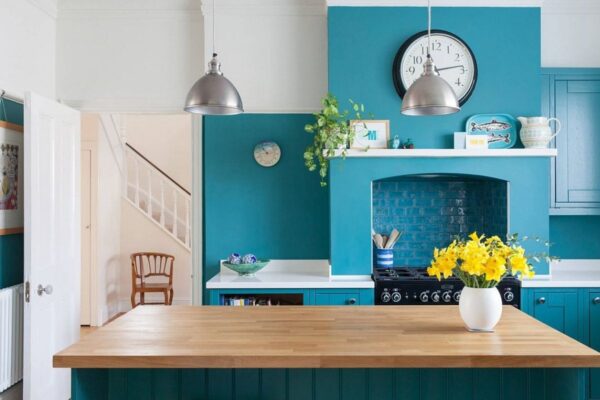
A fresh color and youthful, with an incredible calming effect. Turquoise is a secondary color that comes from the combination of blue and green. It is a very summery shade and that presents numerous nuances, based on the ratio between its basic colors and the amount of white present.
Choose turquoise to paint the kitchen walls it’s a Valid alternative be for the beach house, that in the city. Although this shade of color is very reminiscent of summer, it is possible to play with the undertones and decrease the amount of white present, obtaining a very intense and elegant shade of turquoise, perfect for enhancing even the city kitchen.
Read also: The lightness of turquoise: ideas for the walls of the house
So, if you have decided to paint your kitchen walls in turquoise, you will need to pay special attention pay attention to the choice of the most suitable shade to enhance the furnishings of the whole environment. Furthermore, despite being a very versatile color, must also be considered color combinations with the furniture: what are the winning pairs?
Here are all the best combinations to enhance the brightness of your kitchen. Finally, a look at the choice of most suitable materials, to enhance any shade of turquoise.
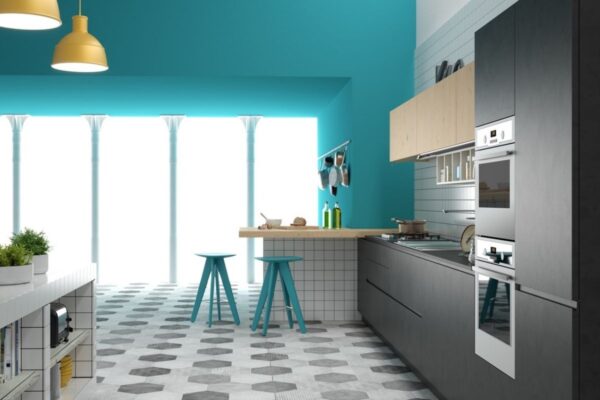
How to choose the ideal shade of turquoise
There is no single shade of turquoise able to enclose all the shades of this magnificent color. By calibrating the amount of white and playing with blue and green, it is possible to obtain numerous color gradations ranging from the lightest and most crystalline shades to the darkest and most intense ones.
Some shades of turquoise have a very marked green undertone, where the presence of yellow affects the final result. In short, the turquoise is a combination of various shades of color that, when mixed together, always offer new and unpredictable variations.
To find yours ideal shade, you can play with various hints of white to get three different shades of color; for greater clarity we can classify them in:
- light turquoise: ideal for to paint small rooms. It gives an immediate brightness and returns a feeling of calm and tranquility;
- medium turquoise: based on the presence of the dominant undertone it can be more blue, or more green. It is a very fresh and youthful color, ideal for giving a cheerful character to environments. In a small kitchen it’s better use it only for one wall;
- dark turquoise: it is the most decisive shade of the turquoise palette and it is also the most difficult to use. Refined and elegant, suitable for very large environments (tends to saturate the space too much). It makes both a classic dark wood furniture and a more contemporary style environment with modern furnishings sophisticated.
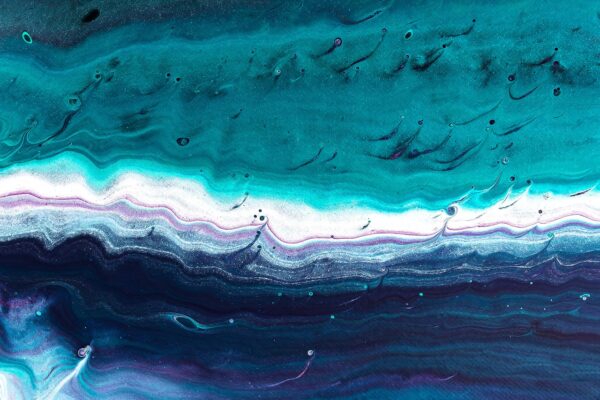
It may interest you: Mistakes not to make when painting kitchen walls
The most beautiful color combinations
Light, medium or dark turquoise? The choice depends essentially the size of the kitchen and the style furniture that best represents you. In all cases, the turquoise colored walls will simply have to act as a background to enhance the color, shapes and materials of the furnishings present, without ever being too intrusive.
Indeed, with the wrong shade you risk burdening the environment obtaining a result that could tire you in a short time and that would force you to opt for a more discreet shade. To go without fail, take a look at our furnishing proposals: here are the winning color combinations to enhance the turquoise walls.
Do you want design advice on how to furnish? Join the group
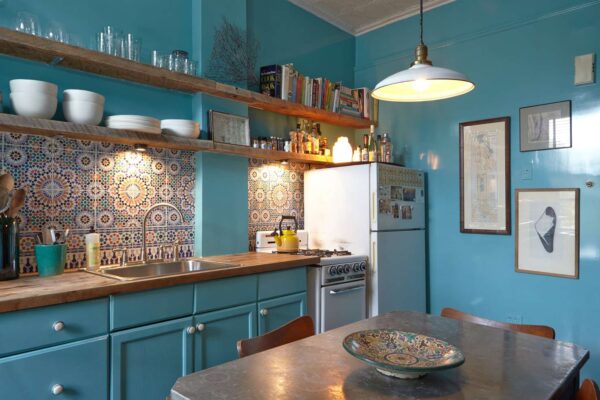
White and turquoise
Any shade of turquoise self combined with white and his one thousand shades it will shine with its own light, giving the environment an elegant and refined allure.
This color combination is particularly indicated in a small kitchen in coastal or marine style, and is perfect for those who do not like too risky combinations but prefer to stay on the classic.
Also for it Scandinavian style there is a perfect variant: light turquoise, combined with optical white, gives the environment light and brilliance, plus a great sense of airiness which is difficult not to fall in love with at first sight.
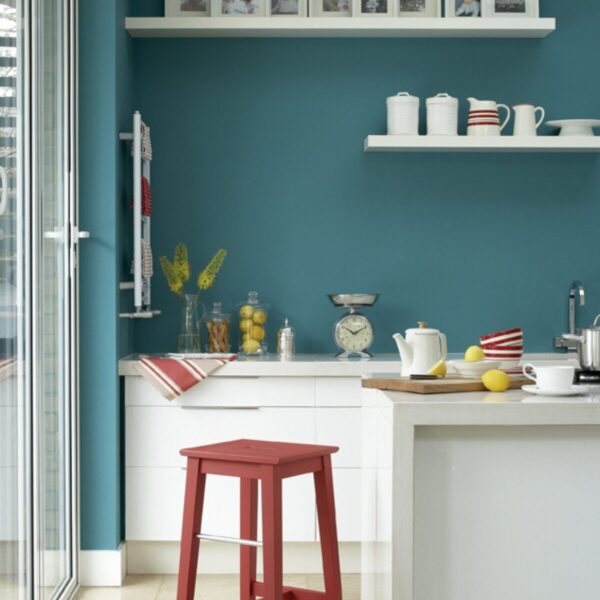
Gray, black and turquoise
The medium-dark turquoise in combination with neutral colors, such as gray or the black, takes on the task of softening the dark character of these colors, giving a refined and elegant appearance to the whole environment.
In particular, gray is enlivened by the freshness of turquoise, both when it comes to lighter shades, and when it is used in its more decisive tones. With blackinstead, it is better to use a stronger shade: the dark turquoise revives the austerity of black, creating a very sophisticated contrast.
But be careful not to overload the environment using turquoise for all walls: better to choose an accent wall and create a contrast, albeit slight, with the other walls, perhaps playing with lighter shades of the same color; or, if you want a sharper contrast, opt for a bright optical white on the rest of the walls.

Yellow and turquoise
The medium turquoise matches in an exceptional way with yellow and all the shades of the earth, from orange terra di Siena, up to its strongest gradations that veer to red.
The combination of these warm colors together with medium turquoise is perfect to enhance retro-style environments: the radiance of yellows and the freshness of turquoise confer to furnishing a cheerful touch and definitely summer.
Also, did you know that the yellow it’s a color that increases appetite? Using it in the kitchen makes the environment a welcoming and convivial place, where eating is always a pure pleasure!
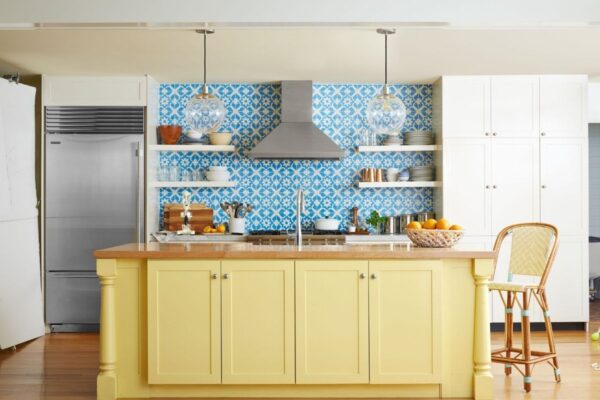
Wooden furniture: cherry and walnut color
Walnut or cherry wood furniture is a furniture must in style classic. But the intense shades of these materials often force rather obvious combinations with lighter neutral colors, such as beige and cream.
If you want give to the environment a burst of color and a touch of character, there is no more valid combination than light turquoise with dark wooden furniture. The stronger shades instead of turquoise are to be preferred in combination with cherry. However, if the space is small, opt for a turquoise accent wall.
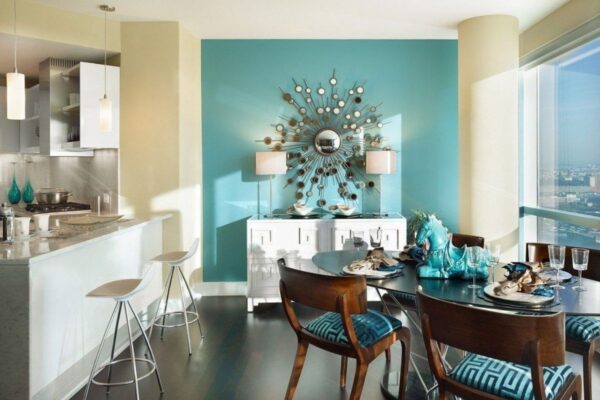
The materials to match
A final consideration must be made regarding the materials winning that best match the turquoise walls. Basically, even if it is a rather versatile shade of color, the most suitable combinations are two:
- the natural materials: wood, rattan and bamboo for furniture, flooring and accessories. These materials highlight the fresh character of turquoise and are particularly suitable in a Scandinavian style, minimal and maritime, because warm the atmosphere and refer to the summer component of this color, which immediately recalls the color of the sea;
- the shiny metals: silver is more suitable for shades of light turquoise and for those where the presence of blue is stronger. Gold and brassinstead illuminate the nuances of dark turquoise and give a more sophisticated and refined imprint to the walls on which a component of green is more visible.

Turquoise kitchen walls: pictures and photos
In this photo gallery we have collected the most beautiful color combinations for the kitchen with turquoise walls: browse through them all and find your favorite color combination.
Would you like to paint the walls in the kitchen turquoise, but you don’t know which shades it is best to combine it with? Here’s how to create a bright and comfortable environment: furnishing ideas and tips, how to choose the ideal shade of turquoise, what are the best color combinations and the most suitable materials to enhance it.

A fresh color and youthful, with an incredible calming effect. Turquoise is a secondary color that comes from the combination of blue and green. It is a very summery shade and that presents numerous nuances, based on the ratio between its basic colors and the amount of white present.
Choose turquoise to paint the kitchen walls it’s a Valid alternative be for the beach house, that in the city. Although this shade of color is very reminiscent of summer, it is possible to play with the undertones and decrease the amount of white present, obtaining a very intense and elegant shade of turquoise, perfect for enhancing even the city kitchen.
Read also: The lightness of turquoise: ideas for the walls of the house
So, if you have decided to paint your kitchen walls in turquoise, you will need to pay special attention pay attention to the choice of the most suitable shade to enhance the furnishings of the whole environment. Furthermore, despite being a very versatile color, must also be considered color combinations with the furniture: what are the winning pairs?
Here are all the best combinations to enhance the brightness of your kitchen. Finally, a look at the choice of most suitable materials, to enhance any shade of turquoise.

How to choose the ideal shade of turquoise
There is no single shade of turquoise able to enclose all the shades of this magnificent color. By calibrating the amount of white and playing with blue and green, it is possible to obtain numerous color gradations ranging from the lightest and most crystalline shades to the darkest and most intense ones.
Some shades of turquoise have a very marked green undertone, where the presence of yellow affects the final result. In short, the turquoise is a combination of various shades of color that, when mixed together, always offer new and unpredictable variations.
To find yours ideal shade, you can play with various hints of white to get three different shades of color; for greater clarity we can classify them in:
- light turquoise: ideal for to paint small rooms. It gives an immediate brightness and returns a feeling of calm and tranquility;
- medium turquoise: based on the presence of the dominant undertone it can be more blue, or more green. It is a very fresh and youthful color, ideal for giving a cheerful character to environments. In a small kitchen it’s better use it only for one wall;
- dark turquoise: it is the most decisive shade of the turquoise palette and it is also the most difficult to use. Refined and elegant, suitable for very large environments (tends to saturate the space too much). It makes both a classic dark wood furniture and a more contemporary style environment with modern furnishings sophisticated.

It may interest you: Mistakes not to make when painting kitchen walls
The most beautiful color combinations
Light, medium or dark turquoise? The choice depends essentially the size of the kitchen and the style furniture that best represents you. In all cases, the turquoise colored walls will simply have to act as a background to enhance the color, shapes and materials of the furnishings present, without ever being too intrusive.
Indeed, with the wrong shade you risk burdening the environment obtaining a result that could tire you in a short time and that would force you to opt for a more discreet shade. To go without fail, take a look at our furnishing proposals: here are the winning color combinations to enhance the turquoise walls.
Do you want design advice on how to furnish? Join the group

White and turquoise
Any shade of turquoise self combined with white and his one thousand shades it will shine with its own light, giving the environment an elegant and refined allure.
This color combination is particularly indicated in a small kitchen in coastal or marine style, and is perfect for those who do not like too risky combinations but prefer to stay on the classic.
Also for it Scandinavian style there is a perfect variant: light turquoise, combined with optical white, gives the environment light and brilliance, plus a great sense of airiness which is difficult not to fall in love with at first sight.

Gray, black and turquoise
The medium-dark turquoise in combination with neutral colors, such as gray or the black, takes on the task of softening the dark character of these colors, giving a refined and elegant appearance to the whole environment.
In particular, gray is enlivened by the freshness of turquoise, both when it comes to lighter shades, and when it is used in its more decisive tones. With blackinstead, it is better to use a stronger shade: the dark turquoise revives the austerity of black, creating a very sophisticated contrast.
But be careful not to overload the environment using turquoise for all walls: better to choose an accent wall and create a contrast, albeit slight, with the other walls, perhaps playing with lighter shades of the same color; or, if you want a sharper contrast, opt for a bright optical white on the rest of the walls.

Yellow and turquoise
The medium turquoise matches in an exceptional way with yellow and all the shades of the earth, from orange terra di Siena, up to its strongest gradations that veer to red.
The combination of these warm colors together with medium turquoise is perfect to enhance retro-style environments: the radiance of yellows and the freshness of turquoise confer to furnishing a cheerful touch and definitely summer.
Also, did you know that the yellow it’s a color that increases appetite? Using it in the kitchen makes the environment a welcoming and convivial place, where eating is always a pure pleasure!

Wooden furniture: cherry and walnut color
Walnut or cherry wood furniture is a furniture must in style classic. But the intense shades of these materials often force rather obvious combinations with lighter neutral colors, such as beige and cream.
If you want give to the environment a burst of color and a touch of character, there is no more valid combination than light turquoise with dark wooden furniture. The stronger shades instead of turquoise are to be preferred in combination with cherry. However, if the space is small, opt for a turquoise accent wall.

The materials to match
A final consideration must be made regarding the materials winning that best match the turquoise walls. Basically, even if it is a rather versatile shade of color, the most suitable combinations are two:
- the natural materials: wood, rattan and bamboo for furniture, flooring and accessories. These materials highlight the fresh character of turquoise and are particularly suitable in a Scandinavian style, minimal and maritime, because warm the atmosphere and refer to the summer component of this color, which immediately recalls the color of the sea;
- the shiny metals: silver is more suitable for shades of light turquoise and for those where the presence of blue is stronger. Gold and brassinstead illuminate the nuances of dark turquoise and give a more sophisticated and refined imprint to the walls on which a component of green is more visible.

Turquoise kitchen walls: pictures and photos
In this photo gallery we have collected the most beautiful color combinations for the kitchen with turquoise walls: browse through them all and find your favorite color combination.


